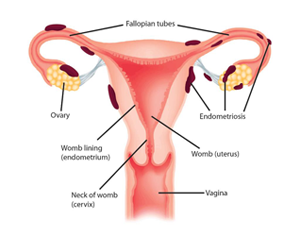|
 Endometriosis is a disease characterized by the presence of tissue which is histologically identical to endometrium (the inner lining of the uterine wall) outside the uterine cavity. Usually, endometriosis is confined to the pelvic and lower abdominal cavity; however, it has occasionally been reported to be in other areas, as well.
Endometriosis is one of the most common problems that gynecologists currently face. It is one of the most complex and least understood diseases in our field and, despite many theories, we still do not have a clear understanding of the cause or of its relationship to infertility. Since this disorder is primarily a human disease and rare in other animal species, accumulation of the facts has been slow. Endometriosis is a disease characterized by the presence of tissue which is histologically identical to endometrium (the inner lining of the uterine wall) outside the uterine cavity. Usually, endometriosis is confined to the pelvic and lower abdominal cavity; however, it has occasionally been reported to be in other areas, as well.
Endometriosis is one of the most common problems that gynecologists currently face. It is one of the most complex and least understood diseases in our field and, despite many theories, we still do not have a clear understanding of the cause or of its relationship to infertility. Since this disorder is primarily a human disease and rare in other animal species, accumulation of the facts has been slow.
Although endometriosis has been considered a pathological or separate disease entity, it may not be a disease at all. It may actually be the clinical manifestation of a more basic underlying disorder, such as a basic chemical or physiological abnormality that affects the tubal motility or immune system which could be responsible for the initiation or progression of endometriosis in patients with retrograde menstrual flow. By the same token, endometriosis may not be the cause of infertility, but the result of it. Historically, it has been shown that sometimes our understanding of a disease has awaited the technology to explain it. This may very well be the case with endometriosis, especially in regard to its immunological aspects. Further technological developments may be necessary in order for us to fully understand this problem. |